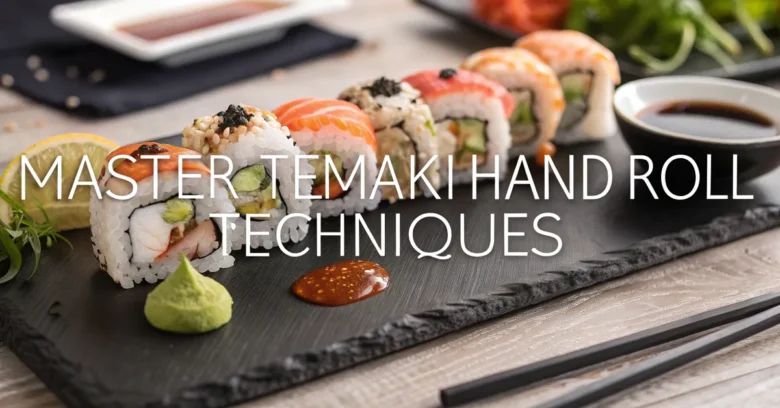Want to impress your friends and family with restaurant-worthy sushi at home? Forget complicated rolls. The answer lies in the elegant simplicity of the temaki, or hand roll. Learning how to master the techniques of a perfect hand roll can unlock a world of flavor and fun in your sushi-making endeavors.
This guide is for intermediate home sushi makers who want to elevate their skills. We’ll break down the process, from prepping ingredients to the final, satisfying bite. No more struggling with bamboo mats or perfectly round shapes, just delicious, personalized sushi in minutes.
Understanding the Art of Temaki: More Than Just a Hand Roll
At its heart, a hand roll is a cone of nori seaweed filled with sushi rice and your favorite ingredients. It’s a casual, rustic style of sushi that emphasizes fresh flavors and customization. But don’t let its simplicity fool you. A truly great hand roll requires attention to detail and a mastery of a few key techniques.
Why Choose Temaki?
- Speed and Ease: Hand rolls are quick to assemble, perfect for weeknight dinners or impromptu gatherings. Forget the fuss of intricate rolls; these come together in minutes.
- Customization: Everyone can create their own perfect bite. Provide a variety of fillings and let your guests (or family) design their own flavor combinations.
- Freshness: Hand rolls are best enjoyed immediately, ensuring the nori stays crisp and the ingredients are at their peak.
- Fun and Interactive: Hand roll parties are a great way to get everyone involved in the meal preparation.
- Less Waste: Unlike some sushi preparations, you only make what you intend to eat immediately, cutting down on potential leftovers.
The Anatomy of a Perfect Hand Roll
To truly master the hand roll, it’s important to understand each component and how it contributes to the overall experience:
- Nori: The seaweed sheet provides the structure and a distinct umami flavor. Its crispness is key to a good hand roll.
- Sushi Rice: Properly prepared sushi rice is the foundation. It should be slightly sticky, seasoned with vinegar, sugar, and salt, and cooled to body temperature.
- Fillings: This is where you get creative! Classic options include fresh seafood, vegetables, avocado, and even cooked proteins.
- Condiments: A dab of wasabi, a sprinkle of sesame seeds, or a drizzle of soy sauce can elevate the flavor profile.
Essential Ingredients and Equipment for Hand Roll Success
Before you dive into the techniques, make sure you have the right ingredients and equipment. Here’s a checklist to get you started:
The Shopping List
- Sushi Rice: Short-grain Japanese rice is essential. Avoid long-grain rice, as it won’t have the right stickiness.
- Rice Vinegar: Seasoned rice vinegar is ideal, but you can also use unseasoned rice vinegar and add your own sugar and salt.
- Nori Seaweed: Look for high-quality nori sheets specifically labeled for sushi. They should be dark green and have a slightly toasted aroma.
- Fresh Seafood: Opt for sushi-grade fish from a reputable source. Salmon, tuna, yellowtail, and shrimp are popular choices.
- Vegetables: Cucumber, avocado, carrots, and sprouts add freshness and texture.
- Optional Fillings: Cooked proteins like crab sticks (imitation crab) or cooked shrimp can add variety.
- Condiments: Wasabi, soy sauce, pickled ginger (gari), and sesame seeds are essential accompaniments.
The Toolkit
- Rice Cooker (Optional): Makes cooking sushi rice a breeze, but a pot works just fine.
- Hangiri (Wooden Sushi Rice Mixing Tub): Helps cool the rice evenly and absorbs excess moisture. A large bowl can substitute.
- Shamoji (Rice Paddle): For gently mixing the rice. A wooden spoon will also work.
- Sharp Knife: For slicing ingredients.
- Cutting Board:
- Small Bowls: For holding fillings and condiments.
Mastering the Sushi Rice: The Heart of the Hand Roll
Great sushi starts with great rice. Follow these steps for perfectly seasoned sushi rice:
Cooking the Rice
- Rinse the Rice: Place the rice in a bowl and cover with cold water. Gently swirl the rice with your hand, then drain the cloudy water. Repeat this process 3-4 times until the water runs clear. This removes excess starch, preventing the rice from becoming gummy.
- Cook the Rice: If using a rice cooker, follow the manufacturer’s instructions. Generally, this involves adding the rinsed rice and the appropriate amount of water (usually a 1:1 rice-to-water ratio). If using a pot, combine the rice and water, bring to a boil, then reduce the heat to low, cover, and simmer for 15-20 minutes, or until all the water is absorbed.
- Let it Steam: Once cooked, let the rice steam, covered, for 10 minutes. This allows the moisture to distribute evenly.
Seasoning the Rice
-
Prepare the Sushi Vinegar: While the rice is steaming, prepare the sushi vinegar. If using seasoned rice vinegar, you can skip this step. If using unseasoned rice vinegar, combine in a small saucepan:
- 1/4 cup rice vinegar
- 2 tablespoons sugar
- 1 teaspoon salt
Heat gently over low heat, stirring until the sugar and salt dissolve. Do not boil. Let cool slightly. - Transfer the Rice: Gently transfer the cooked rice to the hangiri or a large bowl.
- Season the Rice: Pour the sushi vinegar over the rice. Use the shamoji or wooden spoon to gently mix the rice, cutting and folding it rather than stirring. This prevents the rice from becoming mushy. The goal is to evenly distribute the vinegar without crushing the grains.
- Cool the Rice: While mixing, use a fan or a piece of cardboard to fan the rice. This helps it cool quickly and evenly. Continue mixing and fanning until the rice is cooled to body temperature. The rice should be shiny and slightly sticky.
Preparing the Fillings: Freshness and Flavor
The quality of your fillings will directly impact the flavor of your hand roll. Here’s how to prep them like a pro:
Seafood Selection and Handling
- Sushi-Grade is Key: Always use sushi-grade fish from a reputable supplier. This means the fish has been handled and processed according to strict standards to minimize the risk of parasites.
- Proper Storage: Keep seafood refrigerated at all times. Use it as soon as possible after purchasing.
- Slicing Techniques: Slice fish thinly against the grain for the best texture.
-
Common Choices:
- Salmon: Offers a rich, buttery flavor.
- Tuna: Can be lean and mild or rich and flavorful, depending on the cut.
- Yellowtail (Hamachi): Has a clean, slightly sweet taste.
- Shrimp (Ebi): Cooked shrimp provides a sweet, firm texture.
- Safety First: If you’re unsure about handling raw fish, consider using cooked options like shrimp or crab sticks.
Vegetable Preparation
- Wash Thoroughly: Wash all vegetables thoroughly before preparing them.
- Julienne or Thinly Slice: Cut vegetables into thin strips or julienne for easy rolling and even distribution of flavor.
- Avocado: Choose ripe but firm avocados. Slice just before serving to prevent browning. A squeeze of lemon juice can also help.
- Cucumber: Remove the seeds to prevent the hand roll from becoming soggy.
- Carrots: Can be lightly blanched or pickled for a softer texture and more complex flavor.
Creative Filling Ideas
Don’t be afraid to experiment! Here are some other filling ideas to inspire you:
- Spicy Tuna: Combine diced tuna with mayonnaise, sriracha, and sesame oil.
- California Roll Style: Crab sticks, avocado, and cucumber.
- Vegetarian Delight: Tofu, avocado, cucumber, and pickled radish (daikon).
- Smoked Salmon: Adds a smoky richness.
- Eel (Unagi): Glazed and grilled eel offers a sweet and savory flavor.
The Hand Roll Technique: Step-by-Step
Now for the main event! Follow these steps to create beautiful and delicious hand rolls:
- Prepare Your Workspace: Arrange your ingredients and equipment within easy reach. Have a bowl of water nearby to keep your fingers moist, preventing the rice from sticking.
- Position the Nori: Hold a sheet of nori in your non-dominant hand.
- Add the Rice: With slightly wet fingers, take a small handful of sushi rice (about 1/4 cup) and gently spread it diagonally across the lower left corner of the nori. Leave about an inch of space at the edges.
- Add the Fillings: Arrange your desired fillings on top of the rice, also diagonally. Don’t overfill! A small amount of each ingredient is all you need.
- Roll the Cone: Bring the bottom left corner of the nori up and over the fillings, forming a cone shape. Moisten the top right corner of the nori with a dab of water to seal the roll.
- Enjoy Immediately: Serve your hand roll immediately with soy sauce, wasabi, and pickled ginger.
Tips for Perfecting Your Hand Roll
- Don’t Overfill: Too much filling will make the hand roll difficult to close and eat.
- Keep Your Fingers Wet: This will prevent the rice from sticking to your hands.
- Seal it Well: Make sure the nori is sealed tightly to prevent the hand roll from falling apart.
- Eat Immediately: The longer the hand roll sits, the softer the nori will become.
- Practice Makes Perfect: Don’t be discouraged if your first few attempts aren’t perfect. With a little practice, you’ll be a hand roll master in no time!
Advanced Temaki Techniques: Elevate Your Hand Roll Game
Once you’ve mastered the basic hand roll, try these advanced techniques to take your sushi skills to the next level:
Variations on the Nori
- Toasting the Nori: Lightly toasting the nori sheet before rolling can enhance its flavor and crispness.
- Cutting the Nori: You can cut the nori into smaller squares or rectangles for different-sized hand rolls.
- Flavored Nori: Experiment with flavored nori sheets, such as sesame or chili.
Sauces and Embellishments
- Spicy Mayo: A classic addition to many sushi rolls, adding a creamy kick.
- Eel Sauce (Unagi Sauce): A sweet and savory glaze that pairs perfectly with eel or other grilled proteins.
- Sesame Seeds: Toasted sesame seeds add a nutty flavor and visual appeal.
- Microgreens: Add a pop of color and fresh flavor.
- Tobiko (Flying Fish Roe): Adds a salty, crunchy element.
Presentation Perfection
- Elegant Plating: Arrange your hand rolls on a platter with your favorite dipping sauces and garnishes.
- Chopstick Rests: Provide chopstick rests for a more formal presentation.
- Personalized Place Settings: Create individual place settings with a hand roll stand or small plate for each guest.
Addressing Common Hand Roll Challenges
Even experienced sushi makers encounter challenges. Here’s how to troubleshoot some common hand roll problems:
- Soggy Nori: Make sure to use fresh nori and eat the hand roll immediately. Avoid adding too many wet ingredients.
- Rice Falling Apart: Ensure your sushi rice is properly cooked and seasoned. Don’t overfill the hand roll.
- Difficulty Rolling: Practice makes perfect! Keep your fingers wet and use gentle pressure to form the cone shape.
Temaki Party Time: Hosting a Hand Roll Gathering
Hosting a hand roll party is a fun and interactive way to entertain. Here are some tips for a successful gathering:
- Prepare in Advance: Cook the sushi rice and prepare all the fillings ahead of time.
- Set Up a Station: Arrange the ingredients in an organized manner, making it easy for guests to assemble their hand rolls.
- Provide Options: Offer a variety of fillings to cater to different tastes and dietary restrictions.
- Offer Guidance: Show your guests how to roll the hand rolls.
- Relax and Enjoy: Most importantly, have fun! Hand roll parties are meant to be casual and enjoyable.
The Future of Hand Rolls: Trends and Innovations
The hand roll is a classic dish, but there’s always room for innovation. Here are some trends to watch:
- Plant-Based Fillings: With the growing popularity of vegan and vegetarian diets, expect to see more creative plant-based hand roll fillings.
- Global Flavors: Experiment with fillings inspired by different cuisines, such as Korean BBQ or Mexican street corn.
- Sustainable Seafood: Choosing sustainable seafood options is becoming increasingly important.
- DIY Kits: Hand roll kits are becoming more popular, making it even easier to enjoy this dish at home.
Should You Master the Art of Temaki Hand Rolls?
Hand rolls are more than just a quick meal; they’re an experience. The ability to create your own personalized sushi, tailored to your exact tastes, is a rewarding skill. Whether you’re looking for a fun weeknight dinner, an interactive party activity, or simply a new way to enjoy fresh ingredients, mastering hand roll techniques is a worthwhile endeavor. So, gather your ingredients, sharpen your knives, and get rolling! The world of temaki awaits.



